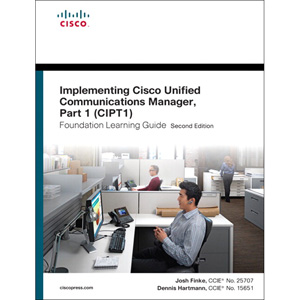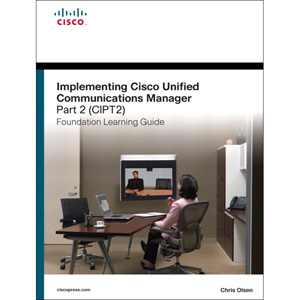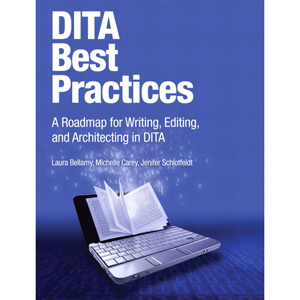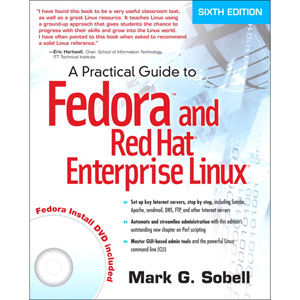5 new posts |  |
- Advanced Mac OS X Programming: The Big Nerd Ranch Guide, 3rd Edition
- Implementing Cisco Unified Communications Manager Part 1 (CIPT1) Foundation Learning Guide, 2nd Edition
- Implementing Cisco Unified Communications Manager Part 2 (CIPT2) Foundation Learning Guide, 2nd Edition
- DITA Best Practices
- A Practical Guide to Fedora and Red Hat Enterprise Linux, 6th Edition
| Advanced Mac OS X Programming: The Big Nerd Ranch Guide, 3rd Edition Posted: 28 Sep 2011 11:37 AM PDT
Book DescriptionWhile there are several books on programming for Mac OS X, Advanced Mac OS X Programming: The Big Nerd Ranch Guide is the only one that contains explanations of how to leverage the powerful underlying technologies. This book gets down to the real nitty-gritty. The third edition is updated for Mac OS X 10.5 and 10.6 and covers new technologies like DTrace, Instruments, Grand Central Dispatch, blocks, and NSOperation. Review "Advanced Mac OS X Programming has long been a required text and source of curriculum for my 10-week Mac and iOS programming course. This new edition brings anticipated updates covering the latest Apple developer technologies. The fresh content keeps this classic book relevant and critical to programmers of all levels working on Apple’s platforms. There is simply no other collection of published material that covers these advanced topics with equal depth and skill." “Many books will introduce you to the basics of Mac OS X programming. Advanced Mac OS X Programming: The Big Nerd Ranch Guide aims for much more, laying out a course for becoming a seasoned expert in many of the nitty-gritty details of developing for the platform.” Table of Contents Book Details
Related Posts
|
| Posted: 28 Sep 2011 11:33 AM PDT
Book DescriptionImplementing Cisco Unified Communications Manager, Part 1 (CIPT1), Second Edition is a Cisco®-authorized, self-paced learning tool for CCNP Voice® foundation learning. This book provides the knowledge necessary to implement a Cisco Unified Communications Manager (CUCM) solution at a single-site environment. By reading this book, you will learn how to perform post-installation tasks, configure CUCM, implement Media Gateway Control Protocol (MGCP) and H.323 gateways, and build dial plans to place On-Net and Off-Net phone calls. You will also implement media resources, IP Phone Services, Cisco Unified Communications Manager native presence, and Cisco Unified Mobility. This book focuses primarily on CUCM version 8.x, which is the call routing and signaling component for the Cisco Unified Communications solution. This book has been fully updated with new coverage of CUCM phone services, Cisco Unified Manager Assistant, Cisco Unified Mobility, and H.323 gateways. Whether you are preparing for CCNP Voice certification or simply want to gain a better understanding of Cisco Unified Communications Manager fundamentals, you will benefit from the foundation information presented in this book. Implementing Cisco Unified Communications Manager, Part 1 (CIPT1), Second Edition, is part of a recommended learning path from Cisco that includes simulation and hands-on training from authorized Cisco Learning Partners and self-study products from Cisco Press. To find out more about instructor-led training, e-learning, and hands-on instruction offered by authorized Cisco Learning Partners worldwide, please visit www.cisco.com/go/authorizedtraining.
This volume is in the Foundation Learning Guide Series offered by Cisco Press®. These guides are developed together with Cisco as the only authorized, self-paced learning tools that help networking professionals build their understanding of networking concepts and prepare for Cisco certification exams. Book Details
Related Posts
|
| Posted: 28 Sep 2011 11:28 AM PDT
Book DescriptionImplementing Cisco Unified Communications Manager, Part 2 (CIPT2), Second Edition is a Cisco®-authorized, self-paced learning tool for CCNP Voice® foundation learning. This book provides you with the knowledge needed to install and configure a Cisco Unified Communications Manager solution in a multisite environment. By reading this book, you will gain a thorough understanding of how to apply a dial plan for a multisite environment, configure survivability for remote sites during WAN failure, and implement solutions to reduce bandwidth requirements in the IP WAN. This book focuses on Cisco Unified Communications Manager (CUCM) Release 8.x, the call routing and signaling component for the Cisco Unified Communications solution. The book has been fully updated and includes new coverage of topics such as Service Advertisement Framework (SAF), and Call Control Discovery (CCD). Whether you are preparing for CCNP Voice certification or simply want to gain a better understanding of deploying Cisco Unified Communications Manager in a multisite environment, you will benefit from the foundation information presented in this book. Implementing Cisco Unified Communications Manager, Part 2 (CIPT2), Second Edition, is part of a recommended learning path from Cisco that includes simulation and hands-on training from authorized Cisco Learning Partners and self-study products from Cisco Press. To find out more about instructor-led training, e-learning, and hands-on instruction offered by authorized Cisco Learning Partners worldwide, please visit www.cisco.com/go/authorizedtraining. Chris Olsen, CCVP, and CCNP, along with numerous other Cisco voice specializations, Microsoft, VMware, and Novell certifications, has been an independent IT and telephony consultant, author, and technical editor for more than 15 years. He has been a technical trainer for more than 19 years and has taught more than 60 different courses in Cisco, Microsoft, VMware, and Novell. For the last seven years he has specialized in Cisco, and recently Microsoft Unified Communications along with VMware virtualization and Cisco data center technologies. He has done a wide array of IT and telephony consulting for many different companies.
This volume is in the Foundation Learning Guide Series offered by Cisco Press®. These guides are developed together with Cisco as the only authorized, self-paced learning tools that help networking professionals build their understanding of networking concepts and prepare for Cisco certification exams. Book Details
Related Posts
|
| Posted: 28 Sep 2011 11:24 AM PDT
Book DescriptionThe Start-to-Finish, Best-Practice Guide to Implementing and Using DITA Darwin Information Typing Architecture (DITA) is today's most powerful toolbox for constructing information. By implementing DITA, organizations can gain more value from their technical documentation than ever before. Now, three DITA pioneers offer the first complete roadmap for successful DITA adoption, implementation, and usage. Drawing on years of experience helping large organizations adopt DITA, the authors answer crucial questions the "official" DITA documents ignore, including: Where do you start? What should you know up front? What are the pitfalls in implementing DITA? How can you avoid those pitfalls? The authors begin with topic-based writing, presenting proven best practices for developing effective topics and short descriptions. Next, they address content architecture, including how best to set up and implement DITA maps, linking strategies, metadata, conditional processing, and content reuse. Finally, they offer "in the trenches" solutions for ensuring quality implementations, including guidance on content conversion. Coverage includes:
If you're a writer, editor, information architect, manager, or consultant who evaluates, deploys, or uses DITA, this book will guide you all the way to success. Book Details
Related Posts
|
| A Practical Guide to Fedora and Red Hat Enterprise Linux, 6th Edition Posted: 28 Sep 2011 11:16 AM PDT
Book Description"I have found this book to be a very useful classroom text, as well as a great Linux resource. It teaches Linux using a ground-up approach that gives students the chance to progress with their skills and grow into the Linux world. I have often pointed to this book when asked to recommend a solid Linux reference." The #1 Fedora and RHEL resource—a tutorial AND on-the-job reference Master All the Techniques You Need to Succeed with Fedora™ and Red Hat® Enterprise Linux® Sobell assumes no prior Linux knowledge. He starts at the beginning and walks you through every topic and task that matters, using easy-to-understand examples. Step by step, you'll learn how to install and configure Linux from the accompanying DVD, navigate its graphical user interface, provide file/print sharing, configure network servers, secure Linux desktops and networks, work with the command line, administer Linux efficiently, and even automate administration with Perl scripts. Mark Sobell has taught hundreds of thousands of Linux and UNIX professionals. He knows every Linux nook and cranny—and he never forgets what it's like to be new to Linux. Whatever you want to do with Linux—now or in the future—you'll find it here. Compared with the other Linux books out there, A Practical Guide to Fedora™ and Red Hat® Enterprise Linux®, Sixth Edition, delivers
Review "I had the chance to use your UNIX books when I when was in college years ago at Cal Poly, San Luis Obispo, CA. I have to say that your books are among the best! They're quality books that teach the theoretical aspects and applications of the operating system." "The book has more than lived up to my expectations from the many reviews I read, even though it targets FC2. I have found something very rare with your book: It doesn't read like the standard technical text, it reads more like a story. It's a pleasure to read and hard to put down. Did I say that?! "Thanks for your work and for the book you wrote. There are really few books that can help people to become more efficient administrators of different workstations. We hope (in Russia) that you will continue bringing us a new level of understanding of Linux/UNIX systems." "Mark Sobell has written a book as approachable as it is authoritative." "Excellent reference book, well suited for the sysadmin of a Linux cluster, or the owner of a PC contemplating installing a recent stable Linux. Don't be put off by the daunting heft of the book. Sobell has striven to be as inclusive as possible, in trying to anticipate your system administration needs." "A Practical Guide to Red Hat® Linux® is a brilliant book. Thank you, Mark Sobell." "This book presents the best overview of the Linux operating system that I have found. . . . [It] should be very helpful and understandable no matter what the reader's background: traditional UNIX user, new Linux devotee, or even Windows user. Each topic is presented in a clear, complete fashion and very few assumptions are made about what the reader knows. . . . The book is extremely useful as a reference, as it contains a 70-page glossary of terms and is very well indexed. It is organized in such a way that the reader can focus on simple tasks without having to wade through more advanced topics until they are ready." "Conclusively, this is THE book to get if you are a new Linux user and you just got into RH/Fedora world. There's no other book that discusses so many different topics and in such depth." Book Details
Related Posts
|
| You are subscribed to email updates from Wow! eBook - Blog To stop receiving these emails, you may unsubscribe now. | Email delivery powered by Google |
| Google Inc., 20 West Kinzie, Chicago IL USA 60610 | |






Tidak ada komentar:
Posting Komentar